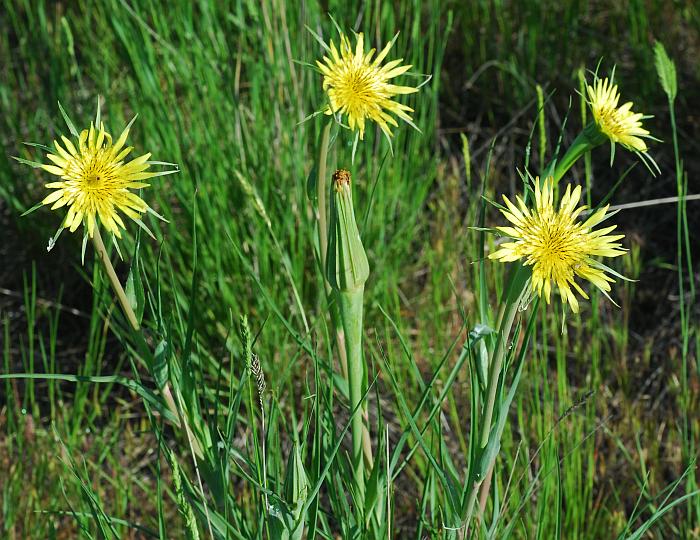Tragopogon dubius Scop.
Yellow Salsify

Introduced
CC = *
CW = 5
MOC = 65
© SRTurner
Tragopogon dubius Scop.Yellow Salsify | |
 |
Introduced CC = * CW = 5 MOC = 65 |
© SRTurner |
|
Family - Asteraceae/Cichorieae Habit - Biennial forb from a massive taproot. Sap milky. Stems - Ascending to erect, to 1 m, sometimes branched, often hollow, usually relatively strongly swollen at the tip, mostly glabrous and often glaucous at maturity.
Leaves - Basal and alternate, sessile, 5-30 cm long, the basal leaves sometimes withered at flowering. Leaf blades grasslike, unlobed, linear from a slightly broadened, more or less rounded base, the margins often slightly corrugated or somewhat incurled and with a narrow, pale band, this often roughened, the surfaces sometimes with small patches of inconspicuous, cobwebby hairs toward the base when young, appearing glabrous at maturity, usually glaucous. Venation of few to several apparently parallel main veins, sometimes the central main vein somewhat thicker than the others, and a sometimes faint network of anastomosing secondary veins.
Inflorescence - Solitary flower head terminating stem. Heads - Ligulate. Involucre 2.5-4.0 cm long at flowering, longer than the florets, becoming elongated to 4-7 cm long at fruiting, the bracts 8-13 in 1 series, all similar, lanceolate, long-tapered at the tip, usually with a narrow, pale margin, glabrous or cobwebby-hairy at the base. Receptacle naked, but often with minute, scaly ridges between the florets. Phylaries much longer than ligules at flowering.
Florets - Ligulate florets fertile, 100-180 or more per head, the corollas 21-28 mm long, usually lemon yellow. Pappus of plumose bristles 12-29 mm long, off-white to straw-colored or less commonly yellowish tan. Styles bifurcate, brownish. Disk flowers absent.
Fruits - Fruits borne in a typically globose cluster which can be up to about 15 cm in diameter. Achenes with the body about 10-14 mm long, narrowly lanceolate to nearly linear in outline, often somewhat curved or asymmetrical, tapered to a slender or relatively stout beak 12-20 mm long, with 5-10 nerves or fine, rounded ribs, the surface with dense tubercles or blunt, ascending barbs, the expanded disc at the tip densely pubescent with short, woolly hairs, the surfaces straw-colored to tan or yellowish to reddish brown.
Flowering - April - August. Habitat - Glades, prairies, pastures, fields, levees, railroads, roadsides, and open, disturbed areas. Origin - Native to Europe. Lookalikes - None when in flower. Other info. - This species is a distinctive sight along roadsides and in fields during late spring and early summer. It is found across Missouri, and throughout the continental U.S. excepting some areas of the deep South. It is easily recognized by the large yellow flowering heads atop stalks which are swollen just beneath the flowers. The phyllaries are longer than the floret ligules, giving the heads a unique spiky appearance when viewed face-on. The flowering heads often exhibit a phototropic response, with the heads in a population all pointing toward the sun (see image below). On sunny days, the heads usually close by about noon. The large, globose clusters of fruits produced later in the season are also distinctive. These are sometimes used in dried floral arrangements after being sprayed with a fixative to prevent dislodging of the fruits.
Photographs taken off Holmes Rd., Jackson County, MO., 4-27-00, off Northwood Rd., Platte County, MO., 8-10-99, and off Hwy 49, near Ironton, MO., 6-1-03 (DETenaglia); also at Weldon Spring Conservation Area, St. Charles County, MO, 6-15-2008, Katy Trail near Dutzow, Warren County, MO, 4-17-2012 and 5-22-2020, Katy Trail near Augusta, St. Charles County, MO, 6-6-2015, and near Three Forks, Gallatin County, MT, 6-11-2015 (SRTurner). |